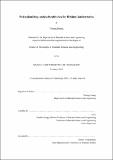Polyanionizing rocksalt cathodes for lithium-ion batteries
Author(s)
Huang, Yimeng
DownloadThesis PDF (16.98Mb)
Advisor
Li, Ju
Terms of use
Metadata
Show full item recordAbstract
Rocksalt-type and olivine polyanion-type cathodes are the two most dominant families of practical lithium-ion battery (LIB) cathodes. Rocksalt-type cathodes, including layered LiCoO₂, [chemical formula] (NCM), spinel LiMn₂O₄ and [chemical formula], and the later-developed disordered rocksalt cathodes (DRX), can have high energy densities up to 1000 Wh kg⁻¹ when utilizing hybrid anion-/cation- redox (HACR) under high upper cutoff voltages > 4.5 V vs. Li/Li⁺. However, anion (oxygen) redox sacrifices cycling stability as oxidized oxide ions [chemical formula] are more mobile than O²⁻, which can lead to percolating lattice oxygen diffusion to the reactive particle surface, oxygen loss, and extensive side reactions with the electrolyte. Meanwhile, polyanion-type cathodes, represented by LiFePO₄, has excellent thermal and structural stability, due to strong covalent bonding in the PO₄ polyanion structure unit that improves structural integrity. But its application is limited by low energy density. While each of them has their own advantages, there was never a marriage between the two materials families for performance-safety synergy.
To achieve high energy density with good cycling stability, we hybridize rocksalt and polyanion-type cathodes by introducing a new cathode family of polyanionized disordered rocksalt cathode with spinel order (DRXPS), where an optimal amount of XO₄ (X = P, S, etc.) polyanions are incorporated in Li-M-O (M = Mn, Fe) rocksalt cathodes, free of Co and Ni. We propose design rules to estimate the optimal polyanion amount, x, such that [XO₄]x is sufficient to suppress long-range percolation of lattice oxygen diffusion/loss at high voltages, while not harming capacity (XO₄ content is much less than that in LiFePO₄). The estimated optimal x by design is verified with electrochemical cycling data. Rules for Li/M/O ratio selection are also proposed and verified experimentally.
The DRXPS cathode family, represented by [chemical formula], can deliver high initial discharge capacities and energy densities up to 367 mAh g⁻¹ and 1122 Wh kg⁻¹, respectively (among the highest for LIB cathodes to date). But most importantly, they can have > 70% capacity and energy density retention after 100 cycles, far exceeding the cycling performance of un-polyanionized DRX with high energy densities. This addresses the cycling stability issues that are the bottleneck for DRX development. The DRXPS cathodes also demonstrate good rate performance and large compositional tunability (similar performance for compositions with varying M, X elements and u, v, x selection). In addition, we clarify their crystal structure, morphology, and redox mechanism via systematic characterizations.
We believe that polyanionization should be a general strategy to address the poor high-voltage cyclability issue, which is a key challenge for earth-abundant cathodes. The superior performance demonstrated and the design rules proposed for DRXPS shed light on the future development of advanced sustainable cathodes.
Date issued
2023-02Department
Massachusetts Institute of Technology. Department of Materials Science and EngineeringPublisher
Massachusetts Institute of Technology